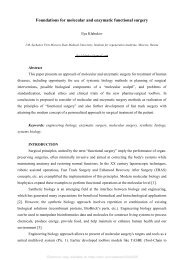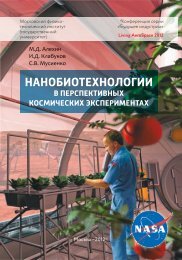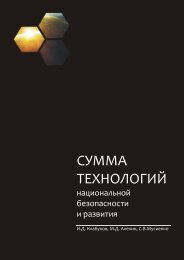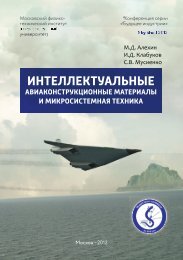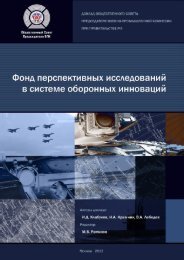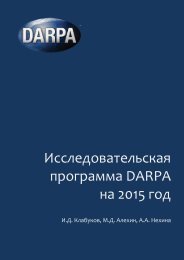Engineering Biology Problems Book (2021, Obninsk Edition)
Create successful ePaper yourself
Turn your PDF publications into a flip-book with our unique Google optimized e-Paper software.
SOLUTION: Since these patients recover abnormally slowly from a flash of bright light, they are
likely based on several models are describing cancer cells indeed differently damaged as a result of
activated rhodopsin returning to its inactive state. This process begins with the phosphorylation of the
rhodopsin’s cytosolic part by a rhodopsin-specific kinase. Then the phosphorylated rhodopsin binds to
arrestin. Additional reactions remove the phosphate and replace all-trans retinals (the end product of
the normal rhodopsin photolysis process) with 11-cis-retinals, eventually regenerating the rhodopsin
molecule, which is ready for the next phototransduction cycle. It was found that patients with
Oguchi's disease have defects in the rhodopsin-specific kinase gene or the arrestin gene (a retinal
protein that controls the photosensitivity of rhodopsin by binding to it).
2.29 Supersoldier. According to the concept of “enhanced warfighters” (DARPA), extending human
survival limits in extreme conditions is supposed to be done via activation of reparation and
regeneration mechanisms as well as cognitive abilities enhancement [43]. Suggest a scheme of
simultaneous activation of tissue-specific oxygen transport and metabolism and extraction
generalization of endogenous blockaders of amino acid neurotransmitters.
SOLUTION: It is clear from the question that the target is hypothalamus cells. However, the task does
not allow us to use only one of the known receptors (ex: vasopressin [44]). We suggest using a
two-stage reaction involving consequential tissue-specific activation of mitochondrial functions and
wide non-specific expression of stress-mediating proteins such as chaperones HSP70 and HSP90 and
interleukins 6 and 8. [45]
[43,44,45. Friedl KE. U.S. Army Research on Pharmacological Enhancement of Soldier Performance.
Journal of Strength and Conditioning Research 2015;29:S71–6. doi:10.1519/JSC.0000000000001027.
Ohbuchi, T., Haam, J., & Tasker, J. G. (2015). Regulation of Neuronal Activity in Hypothalamic
Vasopressin Neurons. Interdisciplinary information sciences, 21(3), 225-234.
Moskalev, A. A., Shaposhnikov, M. V., Shostal, O. A., Plyusnina, E. N., Romanova, E. V.,
Velegzhaninov, I. O.,... & Chernyshova, D. O. (2011). The relationship between the genetic
mechanisms of stress resistance and longevity. Bulletin of the Institute of Biology of the Komi
Scientific Center of the Ural Branch of the Russian Academy of Sciences, (4-5), 33-40.; 73.
Moskalev, A. A., Proshkina, E. N., Bely, A. A., & Solovyov, I. A. (2016). Genetics of aging and
longevity. Vavilovsky Journal of Genetics and Breeding, 20(4), 426-440. ]
2.30 Mission Everest. Researchers Houston and Ryley (the USA) conducted an experiment called
“Mission Everest” in a diving chamber in 1946. 4 males aged between 19 and 27 volunteered for it.
The duration of the experiment was 35 days, 32 out of which the volunteers spent in the diving
chambers. The pressure in the diving chamber was slowly decreasing to mimic an ascend to
mountains. At first, it was “going up” 600 m per day until “the height” of 2400 m; then 300 m until
6000 m; and then 150 m per day until the end of the experiment. On the 27 th day, the volunteers
achieved “the height” of 6850 m and remained there for several days. After that, the investigators
imitated storming the summit by decreasing the pressure in the chambers to 235 millimeters of
mercury – the atmospheric pressure on the peak of Everest [46]. During the 6-hour long “storming”, 2
volunteers needed oxygen, and 2 “made it to the peak” without assistance and spent 30 minutes there.
1. Which experimental conditions provided increased tolerance to hypoxia in the volunteers?
2. What is the name of the form of tolerance to repeated hypoxic conditions the volunteers
developed? What are the mechanisms of development of such tolerance?
3. What are the exact mechanisms of increasing tolerance to hypoxia in the given experimental
settings?
4. Why in the same conditions different healthy or almost healthy men displayed different
degrees of adaptation to hypoxia?
SOLUTION: The solution is under development.





